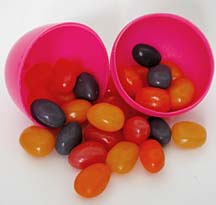
Eleanor Nakama-Mitsunaga
![]()
|
It's the season for beans. Not the legume variety, but the candy variety. Next to chocolate bunnies and marshmallow Peeps, jelly beans are the candy most associated with Easter.
How they became a part of the holiday is unclear, but it is believed the tradition began in the 1930s.
The basics: Jelly beans have been around since the late 1800s. The origin isn't clear, but the candy is believed to have come from a kind of chewy, jelly-like Middle Eastern confection.
The slightly crunchy candy coating, or shell of the jelly bean, comes from a process called panning, developed more than 300 years ago in France. Panning was invented to make Jordan Almonds -- nuts covered with a smooth candy shell.
Jelly beans gained popularity in the penny-candy boom of the late 1800s, when it was common to see a jar of jelly beans at most general stores. Popularity diminished somewhat as Americans focused their sweet teeth on chocolates, but in 1976 the Goelitz Candy Co. (now the Jelly Belly Co.) gave the jelly bean a makeover with wild and true-to-life flavors. The eight new flavors: Very Cherry, Lemon, Cream Soda, Tangerine, Green Apple, Root Beer, Grape and Licorice. Today, Jelly Belly jelly beans come in 50 varieties.
Selecting: Besides Jelly Bellies, sour jelly beans, Starburst jelly beans and Snapple jelly beans are just a few of the varieties available. The traditional bean or mini-egg shape has remained the standard, but flavors are limitless. Jelly beans are generally sold loose in bags and come in various quantities and colors.
Storing: Jelly beans should last several months in a cool, dry area -- or place in a bag in the refrigerator for longer storage.
Use: What's more fun than grabbing a handful of jelly beans from a jar and popping them in your mouth? But, if you're looking to do more with jelly beans for Easter, try using them to decorate cupcakes, cakes, cookies, brownies, fudge, custards and ice cream. Adding them to homemade marshmallow or Rice Krispies treats will also excite the kids.
Where to buy: Although jelly beans are available year-round, now is the peak season. Prices range from 99 cents to $2 a bag, depending on quantity and variety.
Eleanor Nakama-Mitsunaga is
a free-lance food writer. Contact her
online through features@starbulletin.com


